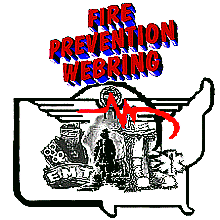Help
Save This Firefighter's Life

 WHEN EVER IN DOUBT, CALL
WHEN EVER IN DOUBT, CALL

 _click here to return to the education pages
_click here to return to the education pages
 FOR MORE INFORMATION ON JUVENILE FIRESETTERS, CONTACT YOUR LOCAL FIRE DEPARTMENT
FOR MORE INFORMATION ON JUVENILE FIRESETTERS, CONTACT YOUR LOCAL FIRE DEPARTMENT



This site created & maintained by

a federally registered trademark of WebArt Plus,Inc 1999-2001.
Copyright
The content of this site, including but not limited to the text and images herein and their arrangement, are copyright й 1998-1999 by Katheran M. Price, Prevention & Safety Educator. All Rights Reserved

This RingSurf Prevention & Safety EducationRing
owned by Oregon Prevention & Safety Educators.
[
Skip Next
|
Next 5 Sites
|
Random Site
|
List Sites
]

